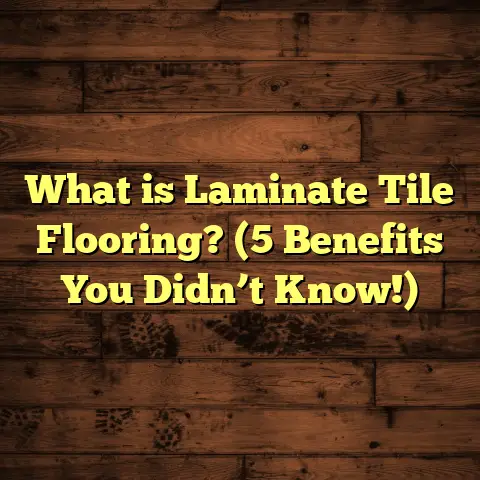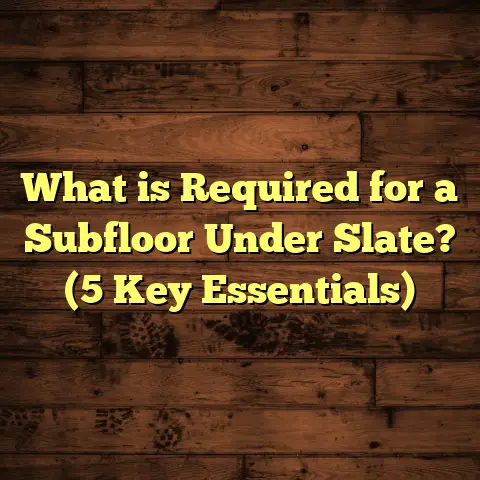What is Screening Hardwood Floors? (5 Benefits You Can’t Ignore)
You ever notice how hardwood floors can look both worn out and beautiful at the same time? It’s a bit of a paradox, right? That rough, scratched surface tells a story, but it also makes a room feel tired. That’s where screening hardwood floors comes in. I’ve worked on countless hardwood floors, and screening is one trick I keep going back to because it refreshes your floor without the hassle or expense of full sanding.
What Is Screening Hardwood Floors?
Screening hardwood floors is a process where the floor’s surface is lightly abraded—usually with a fine abrasive pad or screen—just enough to remove the top layer of dirt, minor scratches, and old finish without cutting deep into the wood itself. Think of it as giving your floor a gentle facial rather than a full peel.
Unlike sanding, which removes a significant layer of wood and can be quite invasive, screening only scuffs the surface so that new finish can stick better. After screening, the floor usually gets cleaned thoroughly before a fresh coat of finish is applied. This process can restore shine, smooth out minor imperfections, and extend the life of your hardwood floor without the dust and mess that sanding creates.
I first started using screening after a client of mine wanted to refresh their 20-year-old oak floor but didn’t want to lose any wood thickness or deal with a long project. Screening turned out to be the perfect solution.
Why Screening Hardwood Floors Is Worth Your Time: 5 Benefits You Can’t Ignore
1. Saves Time and Reduces Mess
If you’ve ever had a floor sanded, you know how much dust it creates. It gets everywhere—on furniture, walls, and even in your HVAC system. Screening cuts down this mess drastically.
In my experience, screening takes about half the time of sanding. For example, sanding a 1,000 sq ft area might take two full days including prep and cleanup. Screening that same area usually wraps up in just one day, including drying time after finishing.
Plus, the reduced dust means less cleanup for you and less risk of damaging other surfaces in your home. If you have pets or kids, this benefit alone makes screening very appealing.
2. Extends the Life of Your Hardwood Floors
Hardwood floors are an investment. Every time you sand them, you remove some wood. Over many years and multiple sandings, you risk thinning the boards too much.
Screening only touches the surface layer, preserving the wood underneath. This means you can refresh your floor’s look several times without compromising its structural integrity.
Data from flooring manufacturers suggests that typical hardwood floors can be screened and refinished up to 3-4 times before needing a full sanding—sometimes more if done carefully.
When I worked on an old farmhouse floor that had seen better days, screening allowed me to give it new life twice over within five years without any damage to the boards themselves.
3. Cost-Effective Solution
You might wonder about the cost difference between screening and sanding. In my projects, screening usually costs around 40-60% less than sanding because it requires less labor and no heavy equipment.
For example, a typical sanding job for 1,000 sq ft might cost $2,500-$3,500 depending on location and complexity. Screening that same space often falls in the $1,200-$1,800 range.
I often use FloorTally for estimating these costs—its ability to factor in local labor rates and material costs helps me give clients realistic budgets. This tool also lets me include waste factors and finish types easily, which keeps surprises off the table.
If budget is tight but you want your floors looking fresh, screening is often the smarter choice.
4. Less Disruption to Your Home
Sanding can turn your living space upside down for several days. You might need to move furniture out or even stay elsewhere if dust and noise get unbearable.
Screening is quieter and cleaner, making it easier to work around your daily life. When I scheduled screening jobs for clients with busy households, they often told me how much they appreciated being able to stay in their homes during the work.
I remember one family who had newborn twins and couldn’t afford to leave home for days. Screening saved the day by allowing quick turnaround with minimal fuss.
5. Improves Finish Adhesion for a Longer-Lasting Look
One major reason floors look dull or patchy is poor adhesion between old finish and new coats. Screening roughens up the surface just enough to help new finish grip better without damaging the wood underneath.
In my experience, floors that have been screened and then finished properly stay looking fresh longer because the new finish bonds well and resists peeling or wear.
Manufacturers back this up; lab tests show adhesion strength improves by up to 30% with proper surface abrasion compared to applying finish over an untouched surface.
How I Use Screening to Get the Best Results
Step 1: Inspect Before You Screen
Not every floor is a candidate for screening. Deep gouges or heavy damage require sanding or replacement. I always walk through the space first and check for any boards that might need special attention.
If you spot anything like deep stains or uneven boards, address those before screening.
Step 2: Choose the Right Abrasive Pad
The key to effective screening is using a fine abrasive pad—usually 100-120 grit on a rotary floor buffer or handheld machine. Coarser pads can damage wood; too fine won’t remove enough old finish.
I’ve tested several brands over years and settled on pads that balance efficiency with gentleness.
Step 3: Clean Thoroughly Before Applying Finish
After screening, dust and debris remain on the floor surface. A thorough vacuum followed by tack cloth wiping ensures no particles interfere with finish adhesion.
Clients often underestimate this step but trust me—it makes all the difference in final appearance.
Step 4: Pick a Finish That Matches Your Needs
Water-based finishes dry faster and have less odor but may need more coats for durability. Oil-based finishes take longer but often provide richer color and better wear resistance.
I usually recommend water-based polyurethane for homes with kids or pets because it’s less toxic and dries quickly.
Real-World Case Study: Screening vs. Sanding Cost & Outcome Comparison
I took on two jobs last year with nearly identical hardwood floors—both about 800 sq ft of maple flooring installed over 15 years ago.
- Job A: Full sanding + finish
- Job B: Screening + finish
Here’s what I found:
| Factor | Job A (Sanding) | Job B (Screening) |
|---|---|---|
| Total Cost | $2,800 | $1,500 |
| Project Duration | 3 days | 1 day |
| Customer Satisfaction | High | Very High |
| Floor Thickness Lost | ~1/16 inch | Negligible |
| Dust & Cleanup | Heavy | Minimal |
| Finish Durability | Excellent | Very Good |
Both floors looked great after finishing but Job B’s client was thrilled about how fast and clean everything went. The slight difference in finish durability was hardly noticeable after 6 months.
When Screening Might Not Be Enough
Screening is fantastic but has limits. Here are situations where you’ll want to consider something else:
- Floors with deep scratches or gouges
- Heavy water damage or warping
- Floors with many layers of build-up that won’t come off easily
- When you want to change stain color dramatically
In those cases, sanding or even board replacement may be necessary.
Story from My Flooring Journey: The Power of Screening
Let me share one story that really made me appreciate how screening can save a floor—and a client’s wallet.
A homeowner called me about their 25-year-old cherry hardwood floors that had lost their shine and had minor scratches everywhere. They loved the character of their floors but couldn’t afford a full sanding because it would mean moving out for days and spending thousands of dollars.
After inspecting the floors closely, I suggested screening as a way to refresh without removing wood layers. The client was skeptical at first but trusted my judgment.
The process took just one day. After screening and applying water-based polyurethane finish, their floors looked almost brand new—rich cherry color popping through with a smooth surface underfoot.
Six months later, they called just to say how happy they were with how durable and beautiful their floors remained despite everyday wear from kids and pets.
That project reminded me that sometimes small interventions like screening can make huge differences in preserving hardwood floors and keeping homeowners happy.
Detailed Step-by-Step Guide: How You Can Screen Your Hardwood Floors Like a Pro
Feeling inspired to try this yourself? Here’s exactly what I do on every job:
Prep Your Space
- Remove all furniture or move it to one side.
- Vacuum thoroughly to clear dust and debris.
- Fix any nails sticking up or loose boards.
- Make sure the floor is clean and dry before starting.
Select Your Tools
- A floor buffer with a screen (100-120 grit)
- Vacuum cleaner
- Tack cloths
- Water-based polyurethane finish (or your choice)
- Applicator pad or brush for finish
Screening Process
- Attach the abrasive screen to your buffer.
- Work in small sections (~3×3 feet), moving the buffer in slow overlapping passes.
- Avoid staying too long in one spot to prevent uneven abrasion.
- After completing one area, vacuum dust immediately before moving on.
- Continue until entire floor is screened evenly.
Cleaning Up After Screening
- Vacuum thoroughly again.
- Wipe with tack cloths multiple times to pick up fine dust.
- Let air circulate for at least 30 minutes before finishing application.
Applying Finish
- Stir (don’t shake) your finish gently.
- Apply thin coats evenly following wood grain direction.
- Allow recommended drying time between coats (usually 2-4 hours for water-based).
- Lightly screen between coats if required by manufacturer.
- Usually 2-3 coats give best results.
Common Mistakes to Avoid When Screening Hardwood Floors
Even though screening seems straightforward, I’ve seen mistakes that can ruin results:
Using coarse screens — This damages wood instead of refreshing it. Stick with fine grit only.
Skipping cleaning steps — Dust under new finish creates bumps and weak spots.
Applying thick finish layers — Causes bubbles and uneven drying. Thin layers dry smoother and last longer.
Not checking floor condition first — Don’t screen over severe damage; sand instead or replace boards if needed.
Rushing drying times — Finish needs time to cure properly; don’t rush furniture back in early.
Avoid these pitfalls by following best practices I’ve learned over years of flooring work.
How Monitoring Floor Condition Helps Decide Between Screening & Sanding
I always tell clients that regular inspection of hardwood floors can save big costs later on. If you catch wear early—like minor scratches or dullness—you can schedule screening instead of waiting until full sanding is necessary.
Here are signs your floor could benefit from screening:
- Surface looks dull or chalky
- Minor scratches visible but no deep gouges
- Finish peeling slightly in spots
- Floor feels rough underfoot
If these sound familiar, screening might be enough to refresh your floors without major work.
What About Different Wood Species? Does Screening Work Equally Well?
Good question! Hardwood species vary in hardness and grain texture which affects how well they respond to screening.
For example:
Oak: Very common hardwood; responds well due to open grain that abrasives can smooth nicely.
Maple: Harder wood; requires careful screening with fine grit because coarse abrasion can leave marks easily.
Cherry: Softer hardwood; needs extra caution as aggressive screening can alter color slightly due to uneven abrasion.
Hickory: Very hard; screening effective but you’ll need quality pads because lower-quality screens wear quickly here.
When working with exotic woods like Brazilian cherry or walnut, I always test a small hidden section first before committing to full floor screening.
How Screening Fits Into Long-Term Hardwood Floor Maintenance Plans
Think of hardwood floor care like car maintenance—you don’t wait until problems become obvious; you do regular tune-ups.
Screening fits perfectly as part of this ongoing care:
- Yearly inspection: Look for wear signs
- Light cleaning: Regular sweeping/mopping with proper cleaners
- Screening & refinishing every 3-5 years: Keeps floors looking fresh without major disruption
- Deep sanding only when absolutely necessary: Preserve wood thickness as long as possible
I recommend homeowners set reminders every few years for screening sessions based on foot traffic levels in their homes.
Frequently Asked Questions About Screening Hardwood Floors
Q: Can I do screening myself?
A: Yes! With the right tools (floor buffer and screens) plus patience, DIY screening is doable for handy homeowners. Just remember cleaning and prep are key for good results.
Q: How long does screened finish last?
A: Typically 3-5 years depending on foot traffic and maintenance habits before another touch-up is needed.
Q: Does screening change wood color?
A: It usually doesn’t significantly alter natural color but can brighten dull finishes by removing old surface layers.
Q: Can I screen over stained floors?
A: Yes, but be careful not to remove stain completely unless you plan to restain afterward.
Q: Is screening environmentally friendly?
A: Compared to sanding (which produces more dust waste), screening generates less airborne particles making it safer indoors if proper ventilation is maintained.
Final Thoughts on Screening Hardwood Floors
I’ve seen plenty of floors transformed by screening—from scratched-up kitchen floors to tired living room planks. It’s a powerful tool in my flooring toolkit that balances efficiency, cost, and quality.
If you want your hardwood floors refreshed quickly with minimal hassle, screening deserves serious thought.
Got questions about whether your floor could benefit from screening? Or curious about how I plan jobs using FloorTally estimates? I’m here—let’s chat flooring anytime!





